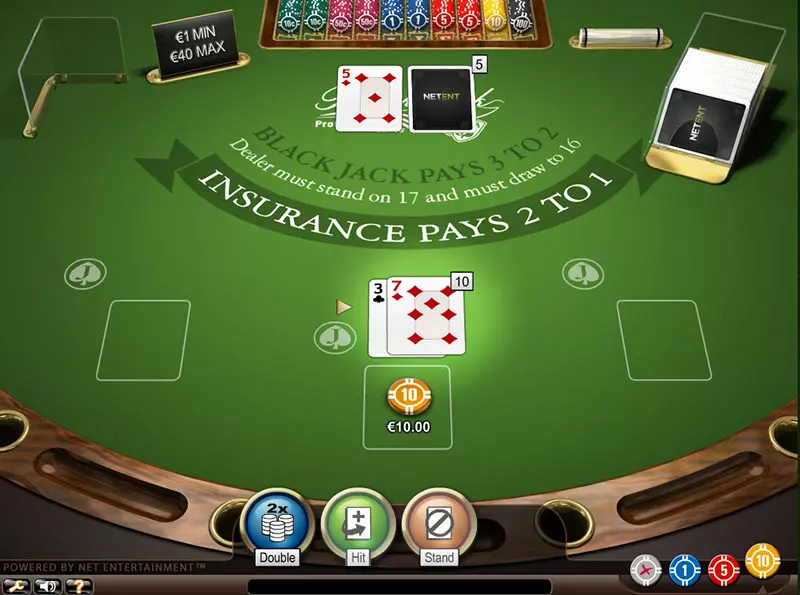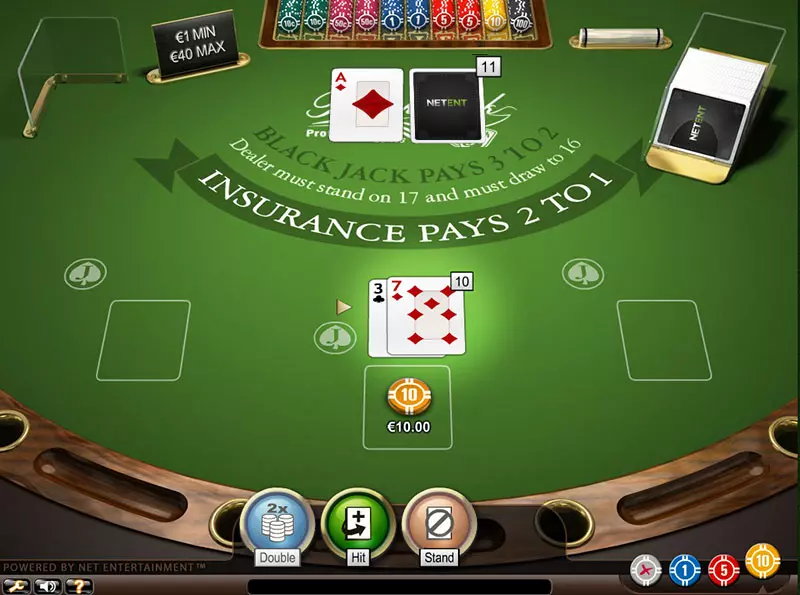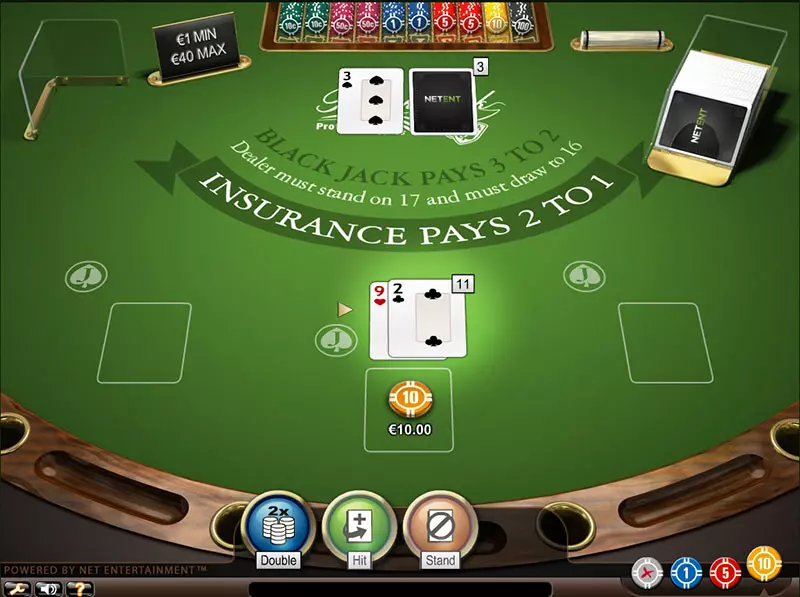Experienced Blackjack players understand the importance of being familiar with all of the possible combinations of their hand and the dealer’s up card. They know that the only way to leave the casino with a profit is if they play cautiously and follow a plan. Of course many other factors play crucial role as well such as their bankroll, money management discipline and practice.
Blackjack requires not only analytical skills but also solid knowledge if players aim at winning in the long run. As any other casino game, it involves money and unless gamblers don’t want to throw them away voluntary, they should put efforts and time in order to memorise every possible situation or at least the most common ones. They can be sure that all of their efforts and time won’t be in vain as the game really pays off in the long run.
In this chapter, we will focus on the two situations when the players’ hand totals value is a ten or an eleven. It is best to observe as many moves as possible in order to help players make a decision which one is the most reliable and reasonable. The moves worth mentioning are the ones which are based on the basic strategy main principles and its variations as they are used by many professional players due to the fact that they have proven to be very accurate.
When the Players’ Hand is 10
In situations when the players’ hand totals 10 or 11, they should consider whether to hit or double down taking into account the dealer’s upcard. Standing is obviously completely counterintuitive here since you only stand a chance of winning if the dealer goes over 21. There are several ways to obtain a hard total of 10 on the initial deal, namely 8-2, 7-3, 5-5, and 6-4.
The following strategy plays are not impacted by the composition of the cards that comprise the hard 10. Deck number, playing conditions, and the dealer’s fixed standing position are also irrelevant when it comes to the correct strategy moves for hard 10.

If the upcard of the dealer is any card from 2 through 9, gamblers should double. But what is the logic behind this play? The main idea here is to extract maximum profits when having a solid total of 10 against a dealer who starts with weaker upcards deuce through 9. Hard 10 against the dealer’s 2 through 9 inevitably puts you at an advantage. Furthermore, doubling down on your 10 yields a higher positive expected value against all these upcards when compared to hitting in the long run.
Inexperienced players often cower at the thought of increasing their stakes against the dealer’s 8 or 9. They choose to tread cautiously instead and hit, which takes away from their long-term expectation. The numbers we cite below are from gambling expert and mathematician Michael Shackleford. They are intended for multiple-deck blackjack with a dealer standing on all 17 where doubling after splitting pairs is allowed.
| EV of Hitting vs. Doubling on 10 against the Dealer’s 8 and 9 | |||
|---|---|---|---|
| EV of 10 vs. 8 | EV of 10 vs. 9 | ||
| Hitting | 0.197954 | Hitting | 0.11653 |
| Doubling Down | 0.286636 | Doubling Down | 0.144328 |
As you can see, either play results in long-term profits for the player. However, the main idea behind doubling down is that it enables you to capitalise on such beneficial situations and boost your winnings.
As becomes apparent, doubling on your 10 when the dealer has an 8 as their upcard earns you £28.66 per every £100 wagered whereas hitting only produces £19.79. The difference of nearly £8.90 is anything but negligible, even more so over the course of thousands of hands played.
Meanwhile, the dealer starts strong when showing anything above 9, which calls for a less aggressive approach. Doubling in this case is no longer optimal since a 10 results in negative expectation for the player against the dealer’s high cards. If the case is that the dealer’s card is a 10 or ace, then players should hit.

| EV of Hitting vs. Doubling Down on 10 against the Dealer’s 10 and Ace | |||
|---|---|---|---|
| EV of 10 vs. 10 | EV of 10 vs. Ace | ||
| Hitting | 0.025309 | Hitting | 0.081450 |
| Doubling Down | -0.008656 | Doubling Down | -0.014042 |
Doubling is not optimal here because you receive only one more card and risk getting stuck with bad stiff hands 12 through 16, which are long-term losers. Remember that the average winning total in blackjack is 18.5.
At the same time, the dealer is in a rather solid position when starting with a 10. Their likelihood of drawing to a total of 20 is very high at around 36% in multiple-deck and double-deck blackjack. Thus, hitting gives the player more flexibility and allows them to potentially improve their situation by drawing more cards on weak hard totals 12 through 16 (as basic strategy recommends against a dealer with a 10 or ace).
Doubling Down with Hand 10
In order to understand the motive behind these moves, let’s have a look at what are the possible outcomes of this situation in case the players decide otherwise – to double down. If gamblers get any card from 2 through 6, the chances that they will go bust are very high.
If the case is that players get a 7, this leaves them with a total of 17 in their hand which is also a weak position to be in. If the dealer has an 18 or more as a total value, the player will lose this one. And the case where gamblers get an 8, seemingly it is not a bad hand, however bear in mind that the average winning score is 18.5 which makes 18 insufficient.
Doubling Down
Splitting Pairs
Blackjack Basic Strategy
Blackjack Hand 8 or 9
Blackjack Hand 10 or 11
The bottom line is that players have the chance to get seven reasonable cards out of the thirteen they can form and the same number of different hands with which they are bound to go bust with. This leaves them with less than 50% chance of drawing a good card which is simply too risky and should be avoided.
What gamblers need to hope for is to get a card 9 or above as this will leave them with a total of 19 or above which is a brilliant hand. This is all that gamblers need to remember for the time when they have hand 10 if they find these moves reasonable enough.
Another thing worth mentioning is that the player would sometimes hold a total of 10 that contains three or more cards like 2-3-5 or 6-2-2. Unfortunately doubling is available only on starting two-card hands and is no longer an alternative with a multiple-card 10.
When this is the case, you exercise the second most optimal move, which is to hit. The same applies to blackjack variations that allow you to double only on certain totals like 9, 10, and 11. This is marked as Dh (double, otherwise hit) in the basic strategy charts.
| Doubling Down with Hand 10 | ||
|---|---|---|
| Dealt Card | Total Score | Hand |
| 2-6 | 12-16 | A Bad Hand |
| 7-8 | 17-18 | An Average Hand |
| 9-Ace | 19-21 | A Brilliant Hand |
What to Do with a Pair of 5s
Some players are quick to split paired 5s whenever the dealer is in a weak position and exposes low-value upcards like 4, 5, or 6, which generally have the highest bust rates for the house. The fact this is an incredibly bad decision is a no-brainer but some people still argue they do it to extract more profits from the dealer’s disadvantageous position.
Indeed, the blackjack dealers’ bust rates are higher with these cards as follows: 39.58% with a 4, 41.84% with the 5, and 42.28% with the 6 (accurate for six-deck games under the S17 rule).
However, before you split, you should take into account the fact you risk breaking a very solid total of 10 and ending up with two terrible stiffs like hard 15 or hard 14. Another thing to keep in mind is that the deck/shoe has already been depleted of some of the cards (5s and 6s) you can use for doubling successfully on one or both split 5s. This further tilts the odds against you when you separate your 5s.
By splitting, the player dismisses an excellent opportunity to double on a solid total. Splitting 5-5 in multiple-deck S17 games results in negative expectation against dealer upcards 4 and 5 as you shall see in the table below.
The expected value of this move against the 6 is positive but is, nevertheless, lower than that of hitting and doubling down. The figures suffice to demonstrate why doubling is the optimal play with 5s versus low dealer upcards. You should never split this pair regardless of what card your dealer shows.
| Expected Value of Holding 5s against the Dealer’s Low Cards 4 through 6 | |||||
|---|---|---|---|---|---|
| EV of 5s vs. 4 | EV of 5s vs. 5 | EV of 5s vs. 6 | |||
| Doubling | 0.46094 | Doubling | 0.512517 | Doubling | 0.57559 |
| Hitting | 0.23047 | Hitting | 0.256259 | Hitting | 0.287795 |
| Splitting | -0.119335 | Splitting | -0.019231 | Splitting | 0.045404 |
When the Players’ Hand is 11 in Single-Deck Blackjack
If players find themselves in a situation when their hand totals 11, the first thing they need to do is to take into account the dealer’s up card and act according to it. It is worthwhile mentioning that here factors such as the dealer’s rules (H17 or S17) and the number of decks have an impact on the correct plays of your 11 versus certain upcards of the dealer.
In blackjack variations that utilize only one deck of cards, players should double down on their total of 11 no matter what the dealer shows. This is an incredibly solid total to begin a hand with. Logically, you want to capitalise on this fact.
Some novices are reluctant to increase their wagers when holding 11 versus the dealer’s ace. The truth of the matter is the win frequency when doubling down slightly decreases in single-deck blackjack against an ace, particularly when the dealer must hit soft 17.
Nevertheless, doubling down is the best play with a total of 11 because it results in twice as large profits, which, in turn, improves the expectation of the player with this hand. And here is the thing many unskilled players forget about. In blackjack (and in gambling, in general), what matters the most is the EV one generates in terms of profits.
A player who books twenty successful double downs on 11 versus an ace with a £10 main bet produces £400 in net earnings. On the other hand (no pun intended), a person who flat bets £10 and wins twenty times with their 11 against the ace by hitting is in for £200 only. The number of hands you have won or lost is not relevant.

Hand 11 in Double-Deck and Multiple-Deck Blackjack
The approach toward 11 versus strong face upcards and aces changes slightly in multiple-deck blackjack as it is influenced by the drawing and standing rules the house has established for the dealer. The correct way to approach your 11 is to double down against upcards deuce through 10, including, versus a dealer who must stand on soft 17, and hit when the dealer has an ace.
The odds in double-deck blackjack tilt slightly in favour of hitting rather than doubling on 11 against the ace. Players should approach the game in more daringly when facing a dealer who hits soft 17.
The total-dependent strategy for double- and multiple-deck H17 blackjack dictates players should double down on their 11 versus the dealer’s ace instead of timidly hitting. Doubling is recommended in H17 games because the dealer’s likelihood of going over 21 increases by nearly 3.5%. This tips the scales in favour of doubling.
Players looking to take their blackjack game to the next level might be interested to know that composition-dependent strategy recommends them to hit 11 versus the ace but only when the hand consists of 3-8 and 2-9.
Hitting is suggested because some of the cards that can help you double down successfully (8 and 9) are no longer in play. As for three-card totals of 11, such as 4-3-4 and 2-3-6, you should hit them since doubling is obviously no longer an option here.
Hand 11 Against the Dealer’s Face Cards
When the dealer reveals the up card and it turns out to be a powerful one, it is really important for players to make the best possible decision as competing against the dealer’s card is a big challenge. Let’s imagine the following situation – the dealer’s up card is a jack and the players’ total value of their hand is eleven. If gamblers draw a two, three, four or five, they will get a maximum value of their hand at the amount of sixteen which is very likely to be a losing hand.
In cases when gamblers get a six, this leaves them with a total of seventeen which is not a good position to be in. If players get a seven, their total becomes eighteen which is not bad but once again a reminder that the average winning hand is 18.5. And the best possible outcome in this situation will be if players are lucky enough to draw an eight, nine, ten or any of the face cards. This leaves them with a brilliant hand of at least nineteen which gives them a very high chance of winning this hand.
| Hand 11 Against the Dealer’s Face Cards | ||
|---|---|---|
| Dealt Card | Total Score | Hand |
| 2-5 | 13-16 | A Bad Hand |
| 6-7 | 17-18 | An Average Hand |
| 8-K | 19-21 | A Brilliant Hand |
Conclusion
In order to understand how Blackjack works and to be able to gain an advantage over the casino, players need to know how to proceed in every situation. There are many strategies which they can choose from and see which one works best for them. Many gamblers start off using one of the basic strategy variations and even though they observe that it doesn’t serve them well, they still continue to use it only because they are afraid of change. Players should make up their mind which way they prefer to conduct their game at the table and stick to it.
| Hand 10 and Hand 11 Basic Strategy Plays for Multiple-Deck S17 Games | ||||||||||
|---|---|---|---|---|---|---|---|---|---|---|
| Players’ Hand | Dealer’s Up Card | |||||||||
| 2 | 3 | 4 | 5 | 6 | 7 | 8 | 9 | 10 | Ace | |
| 10 | Dhh | Dh | Dh | Dh | Dh | Dh | Dh | Dh | H | H |
| 11 | Dh | Dh | Dh | Dh | Dh | Dh | Dh | Dh | Dh | H |
After all players have the power to decide how to proceed in a particular situation but they need to bear in mind that in Blackjack the fundamental method trial and error would come costly. If they want to avoid losing a significant amount of money when playing Blackjack, they need to make sure prior sitting at the table that they know the rules and have the needed knowledge.